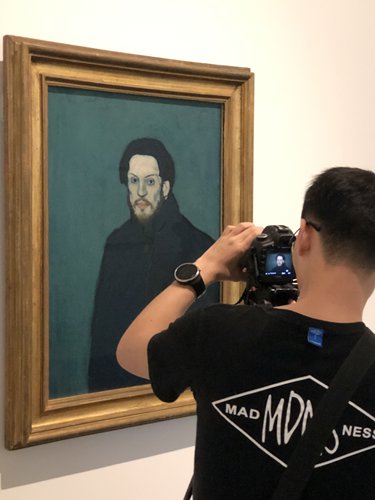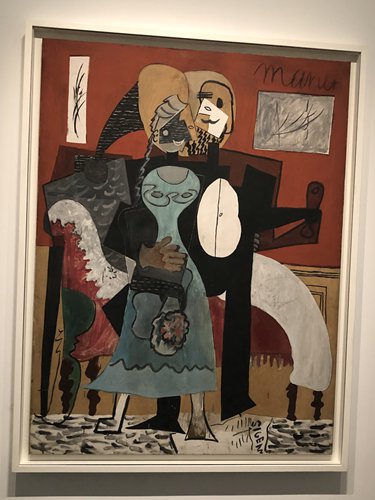
A photographer takes a photo of Picasso's Self-portrait Photo: Xu Liuliu/GT

Pablo Picasso's The Lovers Photo: Xu Liuliu/GT

The First Communion Photo: Xu Liuliu/GT
Around the world, Pablo Picasso is considered a genius of the art world. However, how he achieved such a status is not widely known, especially in China, where there are not many chances to appreciate his works in person.
A new exhibition at Beijing's UCCA Center for Contemporary Art is seeking to change all that by bringing the largest showcase the Spanish artist's works to China.
The exhibition
Picasso - Birth of a Genius includes 103 works from the Musee National Picasso - Paris collection that trace the artist's development from childhood to middle age. According to Emilia Philippot, exhibition curator and head of collections at the Paris museum, the 34 paintings, 14 sculptures and 55 works on paper at the exhibition make up the largest and most significant showcase of the artist's work ever in China.
"The exhibition marks the realization of a dream we have held since our opening in 2007," said Philip Tinari, director of the UCCA at the opening of the exhibition on Friday.
"To present not only recent developments in contemporary art but to examine the underpinnings of contemporary art by showing modern masters. The story of Picasso is relevant to our audience in China, as individuals here continue to answer the challenges of creativity, originality and innovation."
Early years According to the curator, the selection of works created between 1893 and 1921 tells the story of the creative formation and evolution of Picasso.
"We can see how Picasso came to be called a genius," said Laurent Le Bon, the president of the Musee National Picasso - Paris.
Six sections at the exhibition explore the artist's career from young Picasso's artistic explorations and numerous changes to the primitivist explorations which ultimately led to the multiple phases of Cubism.
Starting with The First Picasso, which delves into the artist's creation of works like
Man in a Cap (1895) and
Study of a Torso, After a Plaster Cast (1893-94), the exhibition moves in its section through Picasso's Blue and Rose periods, during which he developed a truly original style in works like
The Jester (1905) and
Two Brothers (1906). The third section, Picasso the Exorcist, examines his revolutionary experiments with form and space in works like
Self-portrait (1906) and preparation for his masterpiece,
Les Demoiselles d'Avignon (1907), while Picasso the Cubist covers the period when he approached a system of signs in works such as
Man with a Mandolin (1911) and
Man with Fireplace (1916). Fifth comes Picasso the Chameleon, which follows his turn toward classical revivalism, when he created works such as
The Lovers (1919) and
Studies (1920), as well as stage design and costumes for the Ballets Russes' production of
Le Tricorne (1919). The final section includes paintings and sculptures done between 1927 and 1972, giving a sense of how Picasso's creative works developed in the latter part of his life.
Strengthening ties Since 1983, Picasso's works have been showcased in China from time to time, big or small. This time's large exhibition is the result of the cultural and artistic exchange between France and China.
According to Tinari at the opening ceremony, as a part of the 2019 Festival Croisements the exhibition represents a significant contribution to the bilateral cultural dialogue between the two countries and echoes French President Emmanuel Macron's hope expressed during his visit to China in January, 2018, to see more exhibitions from major French museums come to China and head from Chinese museums to France as well.
Macron mentioned the Picasso exhibition to Chinese President Xi Jinping when they met at the Elysee Palace in France on March 25, saying that "great projects are being undertaken, such as the biggest exhibition of Picasso's works in China this year."
"We are pleased with this new stage in international cooperation led by the Musee National Picasso - Paris," Le Bon said.
But bringing these valuable artworks from France to China is no easy task. According to a report by AFP, the insurers for the works, which are valued at more than 800 million euros ($900 million), insisted that the pieces travel on seven separate planes to prevent a total loss in case something went wrong.
In addition to the exhibition, the UCCA is also hosting public programs including panel discussions and film screenings titled Adventures with Picasso.
The exhibition is set to run until September 1.






